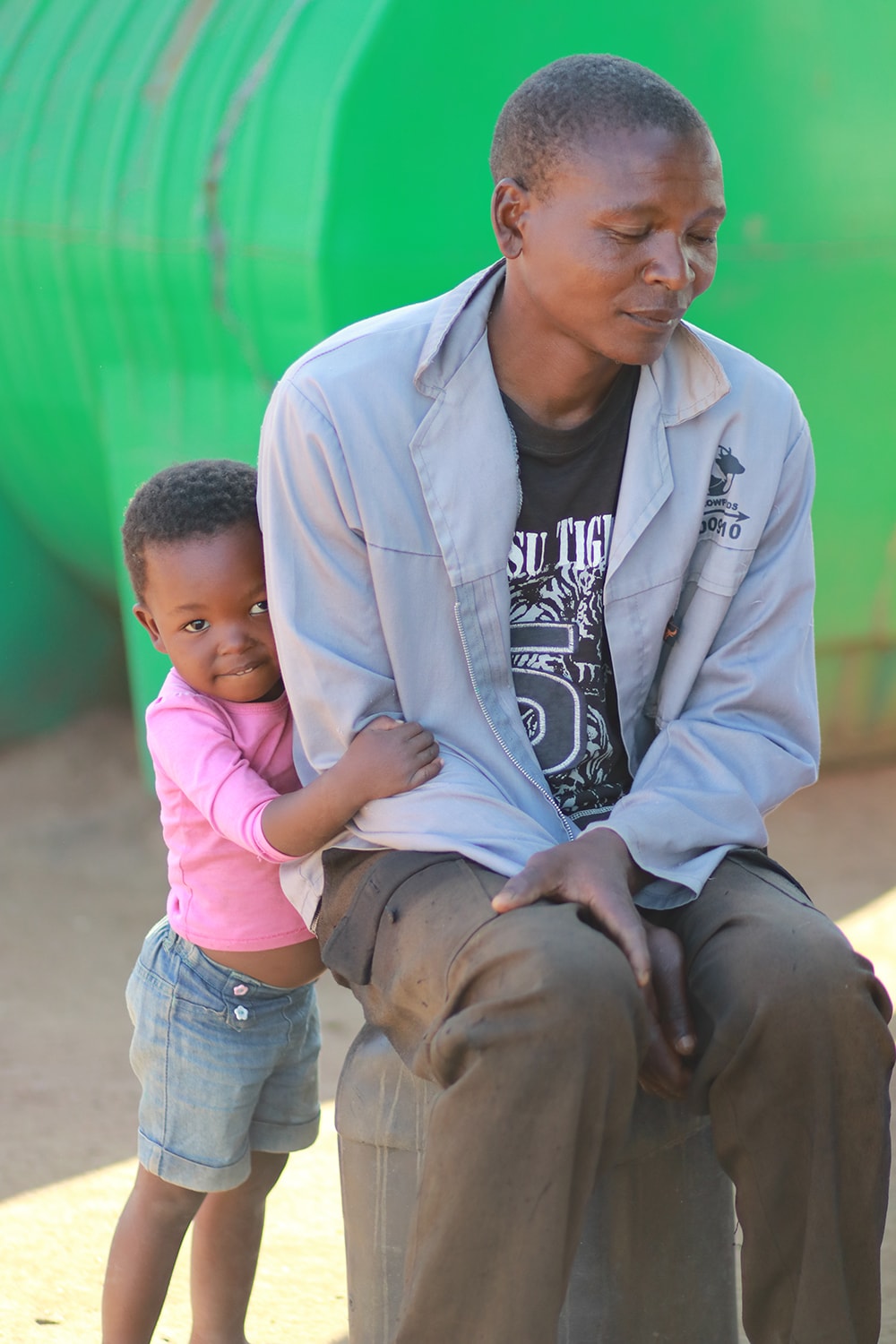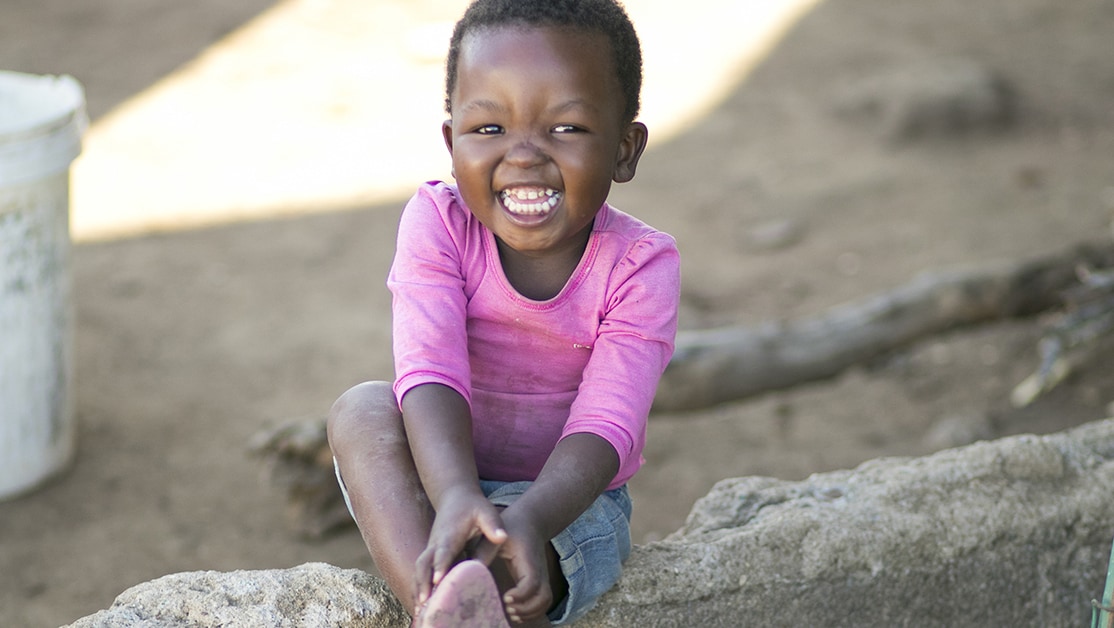At a glance
Increasing the number of pregnant women on life-saving HIV treatment helps mothers live longer, healthier lives and helps eliminate new infections among children. Learn how one farming family in rural Eswatini found hope for their daughter.
The Mndvotis family

Photo by: Brittany K. Moore
The Mndvotis live on a farm about 30 miles off the closest major road in this rural area of Eswatini. A road, which itself is approximately 90 miles from the closest town. Here they grow maize and tend cows in a small, isolated community considered among the poorest in all Eswatini.
It was here, nearly three years ago that they learned of Mrs. Mndvoti's diagnosis: she had HIV. She was also two months pregnant. When they heard the news, they feared the worst.
The antenatal clinic where she received her diagnosis was a two-hour drive, each way, by bus. There, the nurses and doctors explained how critical it was for her to start and stay on HIV treatment– for her own health and for the health and survival of her baby.
She began taking the medicine immediately. Her husband, though a bit cynical at the time, supported her every step of the way. "He was with me so well throughout my whole pregnancy," she remembers. "He came with me to every clinic visit. He provided the money for the regular checkups to make sure our baby was HIV negative and he reminded me every day to take my medicine."
Seven months later, Samkeliso, a little girl, was born – HIV-free. She too was given a course of HIV treatment at six weeks old, in line with WHO* recommendations. Nearly three years later, she remains HIV-negative.
"I was so very happy," Mrs. Mndvoti recalls after she heard the news, "I was so thankful to God and thankful to all the health care workers that helped us along the way."
This mother and daughter are just two of the thousands of women and children whose lives were saved in Eswatini last year thanks to powerful advances in mother-to-child transmission prevention.
Preventing mother-to-child transmission of HIV in Eswatini
Eswatini—a small, landlocked country in southern Africa, where the Mndvotis family lives—is home to the highest HIV prevalence in the world.
In 2010, 41 percent of all pregnant women were HIV positive—an increase from 4 percent in 1992.
As a result, the Government of the Kingdom of Eswatini, with support from PEPFAR, CDC and other global health partners have made preventing mother-to-child transmission (PMTCT) of HIV a national priority.
In 2018, together, they launched a new national program with the goal of reducing and ultimately eliminating transmission of HIV from mothers to children.
"Our goal, ultimately, is to eliminate mother-to-child transmission of HIV," says CDC-Eswatini Director Dr. Caroline Ryan. "We have the tools and we have the will to make this a reality."
Efforts include integrating PMTCT services within all maternal, newborn and child health services, making more effective drug regimens available to pregnant and breastfeeding women to reduce their risk of passing the virus to their newborns, and expanding community-based activities in all regions of the country to increase awareness and education.
Thanks to these efforts, Eswatini has reduced its rate of mother-to-child HIV transmission from 34 percent in 2004 to 1.4 percent in 2020.
Helping to reach the men
During Mrs. Mndvoti's pregnancy, her husband was also tested for HIV. He too was found to have HIV. Despite supporting his wife while she received HIV treatment, he chose not to pursue treatment for himself.
"I was scared," he admits. "I had doubts. I didn't believe in the treatments and I didn't know if they would help me."
But then Samkelisa was born and "that changed everything!" he says. "I could see how these medications had brought my little girl here, healthy and alive. I saw it happen in my own home," he says.

Photo by: Brittany K. Moore
A serious, almost stoic man, his eyes, nonetheless, well up as he recalls. His daughter, as though sensing his emotion, grabs his hand and wraps her tiny palm, tight, around his index finger.
Mr. Mndvoti's story is not unique.
In 2019, only 75 percent of men living with HIV knew their status, as compared to 84 percent of all women living with HIV in the country. Because men are often reluctant to access healthcare, they are less likely to know their HIV status and just as unlikely to be on HIV treatment. It's a troubling reality that is helping to fuel the epidemic in Eswatini and throughout sub-Saharan Africa. One of the ways CDC and partners are tackling this dilemma is by using PMTCT platforms as a springboard for reaching male partners of pregnant women.
Today and towards the future
Today, three years later, both parents are on HIV treatment and have their virus under control—having achieved viral suppression. They are successfully caring for their little girl in this rural farming community.
But maintaining their progress is challenging.
In order to stay on treatment, they have to travel hours each way, every month, to the local health facility to get the medicines they need. And the costs to travel and get medicines are steep— especially considering the income they generate from subsistence farming.
But for now, the Mndvotis remain grateful for their health and the love they get to share as a family.

Photo by: Brittany K. Moore
The apple of her father's eye, 3-year old Samkeliso plays between his knees and jumps gleefully on his lap as he recounts his story in a somber and measured voice. He watches her attentively with a soft, amazed love.
As she poses for a journalist's camera – like a tiny fashion model on her own photo shoot – her mother wonders aloud whether they may be able to expand their family.
"We really want to have another," she says, a mix of hope and concern in her eyes. "He is HIV-positive, yes, and I am HIV positive, but we were able to have Samkeliso. She is our little miracle," she says. "She has helped us believe."
More stories
- *U.S. President's Emergency Plan for AIDS Relief
- *World Health Organization
